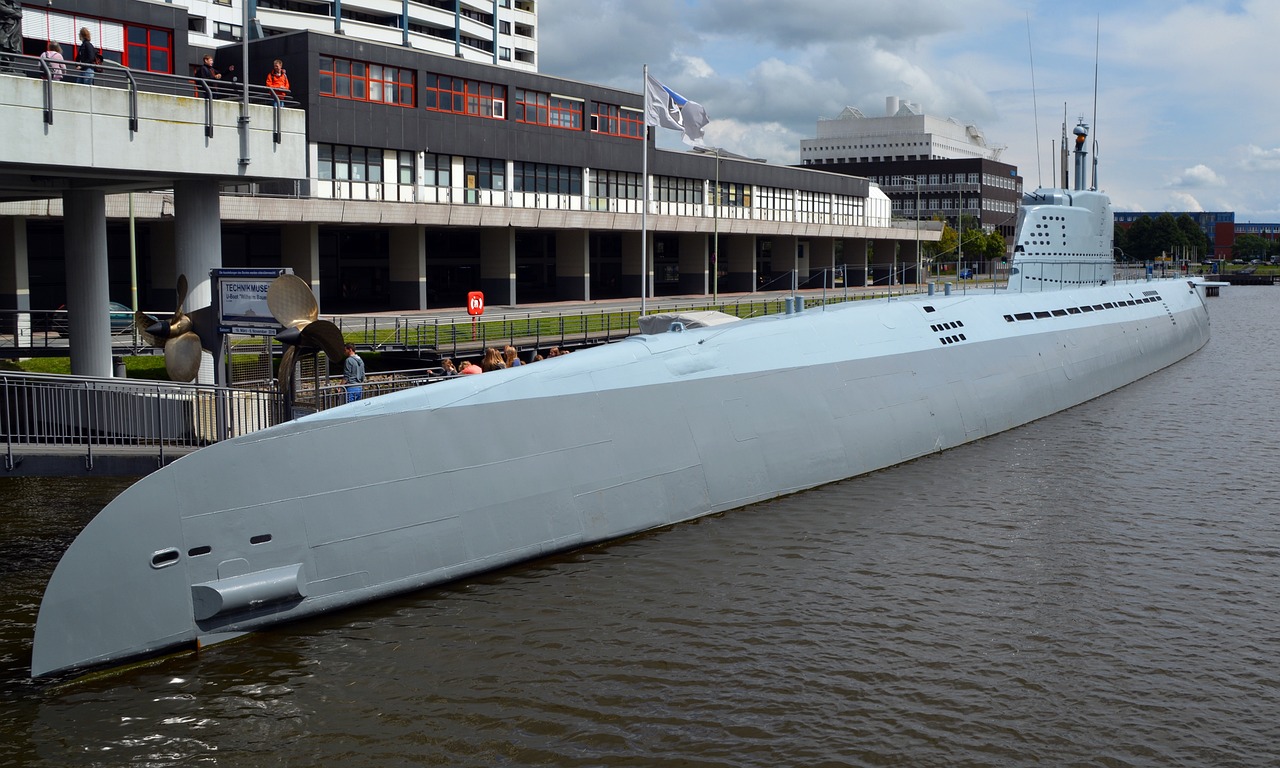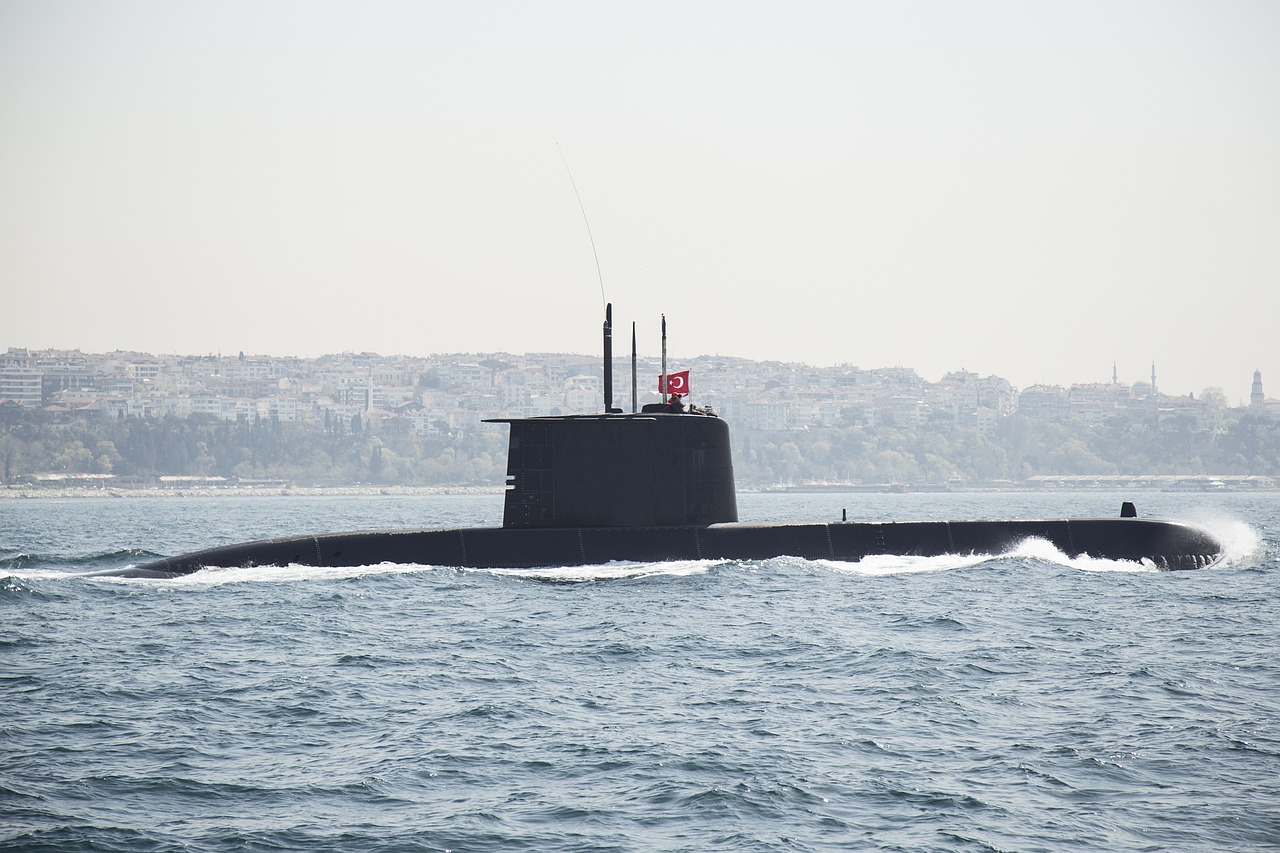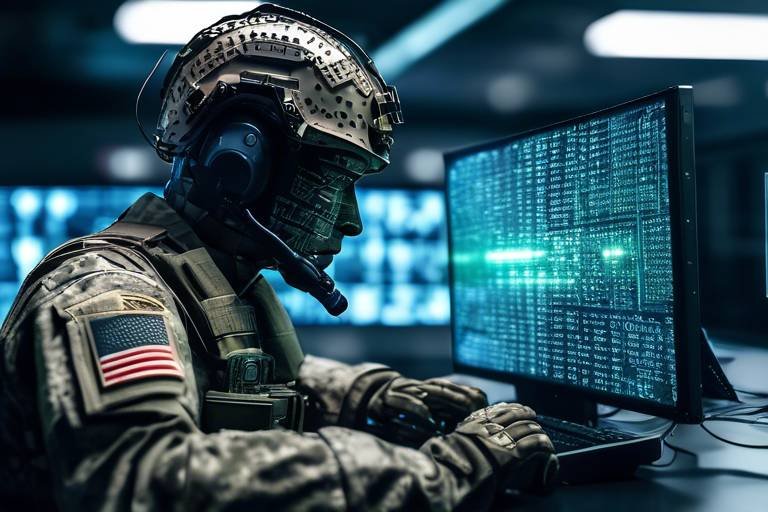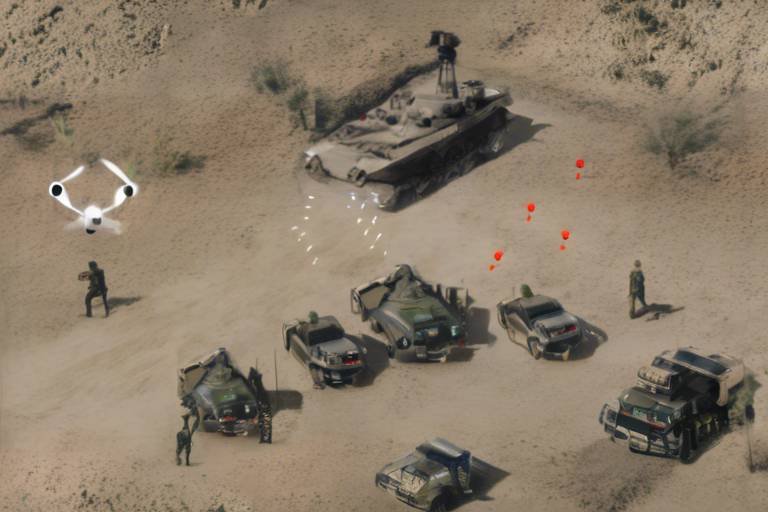AI-Enhanced Submarine Detection Technologies
In today's rapidly evolving world, the need for effective submarine detection technologies has never been more crucial. As nations invest heavily in naval capabilities, the challenge of identifying and tracking submarines—often the silent predators of the ocean—becomes increasingly complex. Enter artificial intelligence (AI), a game-changer that is revolutionizing how we approach underwater warfare and naval security. With AI at the helm, we are witnessing a significant shift in methodologies that not only enhance detection accuracy but also streamline the entire process of submarine monitoring.
Imagine being able to scan vast ocean expanses and pinpoint a submarine's location with pinpoint precision, all while sifting through mountains of data in real-time. This is no longer just a dream; it's a reality made possible by AI-enhanced technologies. Traditional submarine detection methods, such as passive sonar and visual observation, have their limitations, especially in the face of advanced stealth technologies employed by modern submarines. These limitations highlight the urgent need for innovative solutions that can keep pace with the evolving threats beneath the waves.
AI enhances submarine detection through sophisticated algorithms that can learn from vast datasets and adapt to new threats. By leveraging machine learning and deep learning techniques, naval forces can improve target identification, classification, and tracking in complex underwater environments. This is akin to having a highly trained analyst who can sift through the noise and identify the critical signals that indicate the presence of a submarine. As we delve deeper into the methodologies employed in AI-enhanced submarine detection, we will uncover just how transformative these technologies are for naval security.
Moreover, the integration of multiple sensor data through data fusion approaches allows for a comprehensive analysis that significantly boosts detection capabilities. By combining information from sonar, radar, and other systems, AI creates a holistic view of the underwater landscape, enabling quicker and more accurate decision-making. This synergy between various data sources is crucial, especially when facing adversaries that employ advanced evasion techniques.
As we explore the advancements in AI-enhanced submarine detection technologies, it is essential to recognize the implications these innovations have for naval security and underwater warfare. The ability to detect and track submarines with greater accuracy not only enhances national defense but also plays a pivotal role in maintaining peace and stability in international waters. In an age where the stakes are higher than ever, the fusion of AI with traditional submarine detection methods is not just beneficial; it is essential for safeguarding maritime interests.
- What are the main advantages of using AI in submarine detection?
AI significantly improves detection accuracy, reduces false positives, and enhances the ability to process vast amounts of data in real-time. - How does machine learning contribute to submarine detection?
Machine learning algorithms can analyze patterns in sonar data, enabling better identification and tracking of submarines. - What challenges does AI face in submarine detection?
Challenges include data quality, algorithm bias, and the need for human oversight to ensure ethical considerations are met. - Why is data fusion important in submarine detection?
Data fusion integrates information from various sensors, providing a more comprehensive understanding of the underwater environment and improving detection capabilities.

Introduction to Submarine Detection
Understanding the fundamentals of submarine detection is essential for any discussion surrounding modern naval defense. Submarines, often referred to as the "silent service," operate stealthily beneath the waves, making them challenging to detect. Traditional methods of detection, such as sonar and radar, have been the backbone of naval strategies for decades. However, these methods come with their own set of limitations. For instance, sonar can be affected by environmental conditions like temperature and salinity, which can distort sound waves and lead to false negatives. Similarly, radar is less effective underwater, making it a less viable option for detecting submerged threats.
The need for innovative solutions has never been more pressing. As global tensions rise and naval engagements become increasingly complex, the ability to detect submarines accurately and efficiently is crucial. It’s akin to finding a needle in a haystack; the stakes are high, and the consequences of failure can be dire. This is where advancements in technology come into play, particularly through the integration of artificial intelligence (AI) into detection systems. By leveraging AI, we can enhance our detection capabilities, allowing for more precise identification and tracking of submarines in real-time.
Moreover, the introduction of AI into submarine detection is not just about improving existing technologies; it's about revolutionizing how we approach naval warfare. Imagine a system that can analyze vast amounts of sonar data in a fraction of the time it would take a human operator, identifying patterns and anomalies that could indicate the presence of a submarine. This is not science fiction; it's the future of naval security. As we delve deeper into the methodologies employed in AI-enhanced detection, it becomes clear that the implications extend beyond mere technology—they touch upon the very fabric of naval strategy and security.
To fully appreciate the significance of these advancements, it’s crucial to grasp the various traditional detection methods and their shortcomings. Here’s a brief overview:
| Method | Advantages | Limitations |
|---|---|---|
| Sonar | Effective in underwater detection | Susceptible to environmental interference |
| Radar | Good for surface detection | Limited effectiveness underwater |
| Visual Observation | Direct and immediate | Highly dependent on weather and visibility |
In summary, the journey toward enhanced submarine detection is fraught with challenges, but the integration of AI offers a promising path forward. As we explore the transformative role of AI in detection, it becomes evident that the future of naval security hinges on our ability to adapt and innovate in the face of evolving threats.

The Role of AI in Detection
Artificial Intelligence (AI) is revolutionizing the way we detect submarines, transforming traditional naval strategies into sophisticated, data-driven approaches. Imagine navigating through the vast, murky depths of the ocean, where sound travels differently, and identifying a lurking submarine is akin to finding a needle in a haystack. AI is like a powerful flashlight cutting through that darkness, illuminating targets that would otherwise remain hidden. By employing advanced algorithms, AI enhances our ability to spot, classify, and track submarines in real-time, making naval operations more efficient and effective.
At the heart of this transformation are machine learning algorithms, which enable systems to learn from vast amounts of sonar data. These algorithms are designed to recognize patterns and anomalies in underwater acoustics, allowing for quicker and more accurate detection of submarines. For instance, they can differentiate between the sounds of marine life, underwater currents, and the distinct noises produced by submarines. This capability is crucial because traditional methods often struggle with high false-positive rates, leading to wasted resources and missed threats.
One of the standout techniques within AI is deep learning, a subset of machine learning that mimics the way humans learn. Deep learning models analyze complex data sets and improve their accuracy over time. In submarine detection, these models process sonar signals and enhance detection accuracy significantly. They reduce the chances of false positives, ensuring that naval forces can focus on genuine threats rather than being misled by noise. This is particularly important in military operations, where the margin for error is razor-thin.
Furthermore, AI employs data fusion approaches, which combine information from multiple sensors, including sonar, radar, and satellite data. This integration allows for a comprehensive view of the underwater environment, significantly enhancing detection capabilities. For example, a submarine's presence can be inferred not just from sonar readings but also from environmental data, such as temperature and salinity changes, which can indicate its movement. By synthesizing this information, AI systems can provide a more accurate picture of underwater activities.
Automated surveillance systems are another exciting application of AI in submarine detection. These systems continuously monitor vast oceanic areas, using AI to analyze incoming data in real-time. Imagine having an army of digital sentinels patrolling the seas, ready to alert naval forces at the first sign of an enemy submarine. This level of monitoring not only increases situational awareness but also allows for rapid response to potential threats, enhancing overall naval security.
In summary, AI's role in submarine detection is transformative, providing sophisticated tools that enhance our ability to identify and track underwater threats. Through machine learning, deep learning, and data fusion, AI is not just a technological advancement; it is a game-changer in naval warfare. As we continue to develop these technologies, the implications for naval security and underwater warfare are profound, promising a future where our oceans are safer and more secure.
- How does AI improve submarine detection? AI enhances submarine detection by using machine learning algorithms to analyze sonar data, reducing false positives, and improving target identification.
- What are deep learning techniques? Deep learning is a subset of machine learning that uses neural networks to process large amounts of data, enabling more accurate detection of submarines.
- What is data fusion? Data fusion involves combining data from various sensors to create a comprehensive understanding of the underwater environment, enhancing detection capabilities.
- Are there ethical concerns with AI in military applications? Yes, the use of AI in military applications raises ethical questions, particularly regarding autonomous decision-making and the potential for unintended consequences.

Machine Learning Algorithms
Machine learning algorithms are at the forefront of revolutionizing submarine detection technologies, acting like a digital detective in the vast ocean depths. These algorithms process enormous datasets, often gathered from sonar systems, to identify and classify submarines with remarkable precision. Imagine having a highly trained eye that can sift through thousands of images in seconds—this is what machine learning does for underwater acoustics. By leveraging statistical techniques and computational power, these algorithms can detect patterns that human operators might overlook.
One of the key advantages of machine learning in this context is its ability to learn from data. This means that the more data these systems process, the better they become at recognizing the unique signatures of submarines. For instance, they can differentiate between the sounds produced by a submarine and those created by marine life or underwater machinery. This capability is crucial because false positives can lead to unnecessary military responses or wasted resources.
Several machine learning algorithms are commonly employed in submarine detection, each with its unique strengths. Some of the most notable include:
- Support Vector Machines (SVM): These are used to find the optimal boundary that separates different classes of data, making them effective for classification tasks in sonar data.
- Random Forests: This ensemble learning method combines multiple decision trees to improve accuracy and robustness, making it particularly useful for noisy underwater environments.
- Neural Networks: These algorithms mimic the human brain's architecture and are adept at recognizing complex patterns, making them suitable for deep learning applications in underwater acoustics.
Moreover, the integration of these algorithms into existing systems is not without its challenges. For instance, the algorithms require substantial computational resources, particularly when dealing with real-time data streams. Additionally, the effectiveness of these algorithms hinges on the quality of the training data. If the data is biased or incomplete, the algorithm's performance can suffer, leading to inaccurate detections.
Furthermore, the development of machine learning algorithms is an ongoing process. Researchers are continuously refining these algorithms to enhance their accuracy and efficiency. Techniques such as transfer learning, where models trained on one task are adapted for another, are being explored to improve submarine detection capabilities. This not only saves time and resources but also allows for the incorporation of diverse datasets, which can lead to better generalization in detection tasks.
In conclusion, machine learning algorithms represent a significant leap forward in submarine detection technologies. By harnessing the power of data and advanced computational techniques, these algorithms enhance naval security and provide a crucial edge in underwater warfare. As we continue to refine these technologies, the future of submarine detection looks increasingly promising, paving the way for safer and more effective maritime operations.
- What are machine learning algorithms? Machine learning algorithms are computational methods that allow systems to learn from data and improve their performance over time without being explicitly programmed.
- How do these algorithms improve submarine detection? They analyze vast amounts of sonar data to identify patterns and classify objects, making it easier to detect submarines amidst other underwater noises.
- What challenges do machine learning algorithms face in submarine detection? Challenges include data quality, computational resource requirements, and the need for ongoing refinement to adapt to new detection scenarios.

Deep Learning Techniques
Deep learning techniques have revolutionized the field of underwater acoustics, providing unprecedented accuracy in submarine detection. These techniques, which involve neural networks with multiple layers, are capable of learning complex patterns from vast amounts of data. Imagine trying to find a needle in a haystack; now imagine if you had a supercharged magnet that could not only find the needle but also distinguish it from other metal objects. This is essentially what deep learning does for sonar data.
One of the most significant advantages of deep learning is its ability to process and analyze high-dimensional data. For instance, when sonar systems capture sound waves, these waves can be represented as intricate patterns in a multi-dimensional space. Deep learning algorithms, particularly Convolutional Neural Networks (CNNs), excel at recognizing these patterns, enabling them to identify submarines with remarkable precision. The ability to differentiate between various underwater objects—like marine life, underwater structures, and submarines—means that naval forces can respond more effectively to potential threats.
Moreover, deep learning models can be trained on historical data, learning from past encounters to improve future detections. This is akin to how a seasoned detective uses past case files to solve new mysteries. By feeding these models with diverse datasets, including both successful and unsuccessful detection scenarios, they become adept at minimizing false positives. This reduction in false alarms is crucial, as it allows naval operations to focus resources on genuine threats rather than chasing down false leads.
However, implementing deep learning techniques is not without challenges. The success of these models hinges on the availability of high-quality, labeled data. In underwater environments, gathering such data can be logistically challenging and expensive. Additionally, the performance of deep learning models can be affected by environmental factors such as temperature, salinity, and background noise. These variables can distort sonar signals, complicating the training process.
To illustrate the impact of deep learning on submarine detection, consider the following table that summarizes key advantages and challenges:
| Advantages | Challenges |
|---|---|
| High accuracy in target identification | Dependence on quality and quantity of data |
| Ability to learn from vast datasets | Environmental factors affecting sonar signals |
| Reduction in false positives | Complexity of model training and deployment |
In conclusion, deep learning techniques are transforming submarine detection technologies, making them more efficient and reliable. As these methods continue to evolve, they hold the promise of significantly enhancing naval security and operational effectiveness. The future of underwater warfare may very well depend on how effectively we can harness the power of deep learning to detect, classify, and track submarines in the vast and often unpredictable ocean.
- What are deep learning techniques? Deep learning techniques involve neural networks that can learn complex patterns from large datasets, making them highly effective for tasks such as submarine detection.
- How do deep learning algorithms improve submarine detection? These algorithms process sonar data to accurately identify and classify underwater objects, reducing false positives and improving response times.
- What challenges do deep learning models face in underwater environments? Challenges include the need for high-quality data, the impact of environmental factors on sonar signals, and the complexity of training models.

Data Fusion Approaches
In the realm of submarine detection, serve as a powerful tool that integrates information from multiple sources, enhancing the overall detection capabilities. Imagine trying to solve a jigsaw puzzle with scattered pieces; each piece represents data from various sensors. Alone, they may not provide a complete picture, but when combined, they create a clearer understanding of the underwater environment. This is precisely what data fusion achieves in naval operations.
Data fusion involves the amalgamation of data from various sensors such as sonar, radar, and satellite imagery. Each sensor has its strengths and weaknesses; for instance, sonar is excellent for detecting underwater objects, while radar excels in surface detection. By integrating these diverse data streams, naval forces can gain a comprehensive view of potential threats, significantly improving their response capabilities. This multi-sensor approach not only enhances detection accuracy but also helps in reducing false positives, which can be a significant issue in traditional detection methods.
To illustrate the effectiveness of data fusion, consider the following table that outlines the strengths and weaknesses of different sensor types:
| Sensor Type | Strengths | Weaknesses |
|---|---|---|
| Sonar | Effective in detecting underwater objects | Limited range and affected by environmental noise |
| Radar | Excellent for surface detection | Cannot penetrate water; limited effectiveness underwater |
| Satellite Imagery | Wide area coverage; can detect large objects | Limited detail; affected by weather conditions |
By employing advanced artificial intelligence algorithms, data fusion systems can not only process this diverse information efficiently but also draw meaningful insights from it. For instance, AI can analyze patterns and anomalies across datasets, enabling quicker identification of submarines or other underwater threats. This capability is particularly crucial in the context of modern naval warfare, where speed and accuracy can mean the difference between success and failure.
Furthermore, the integration of real-time data from these sensors allows for timely decision-making. Imagine a scenario where a submarine is detected by sonar, and the system simultaneously analyzes radar data to track surface ships in the vicinity. This real-time fusion of information empowers naval commanders to make informed tactical decisions swiftly, enhancing the effectiveness of naval operations.
However, it is essential to recognize that while data fusion approaches offer significant advantages, they also introduce complexities. The challenge lies in ensuring that the data being fused is of high quality and that the algorithms used for analysis are free from bias. Continuous monitoring and refinement of these systems are necessary to maintain their effectiveness in dynamic underwater environments.
- What is data fusion in submarine detection?
Data fusion is the process of integrating data from multiple sensors to create a comprehensive understanding of the underwater environment, enhancing detection capabilities. - How does AI improve data fusion?
AI algorithms analyze and process large volumes of data from various sensors, identifying patterns and anomalies that improve detection accuracy and reduce false positives. - What types of sensors are commonly used in data fusion?
Common sensors include sonar, radar, and satellite imagery, each contributing unique strengths to the detection process. - What challenges are associated with data fusion?
Challenges include ensuring high-quality data, managing algorithm bias, and maintaining system effectiveness in changing underwater conditions.

Automated Surveillance Systems
In the vast, uncharted waters of the world's oceans, the need for effective submarine detection has never been more critical. Traditional methods of monitoring these depths have often fallen short, leading to a pressing demand for innovative solutions. Enter , a groundbreaking approach that leverages the power of artificial intelligence (AI) to enhance our ability to track and identify submarines in real time. These systems are designed to operate continuously, tirelessly scanning large expanses of ocean, much like a vigilant sentinel watching over its territory.
At the heart of these automated systems lies a sophisticated network of sensors, including sonar, radar, and satellite technology. By integrating data from these various sources, AI algorithms can analyze patterns and anomalies that would be nearly impossible for human operators to detect alone. Imagine trying to find a needle in a haystack; now, imagine having a highly intelligent magnet that not only finds the needle but also sorts through the hay to identify which pieces are relevant. This is precisely what automated surveillance systems do—they enhance detection capabilities by synthesizing information from multiple inputs.
The design of these systems is not just about collecting data; it’s about making sense of it. With advancements in machine learning and deep learning, these systems are capable of learning from past encounters and refining their detection algorithms over time. They can differentiate between various underwater objects, significantly reducing false positives that could lead to unnecessary military responses. For instance, the systems can distinguish a submarine from marine life or debris, ensuring that the focus remains on genuine threats.
Moreover, the implementation of automated surveillance systems allows for a level of operational efficiency that is crucial in modern naval warfare. These systems can monitor vast areas without the fatigue that human operators would experience. Imagine having a watchman who never sleeps, always alert and ready to report any suspicious activity. This continuous vigilance enables naval forces to respond more swiftly and effectively to potential threats, thereby enhancing overall security.
However, while the promise of automated surveillance systems is immense, it is essential to recognize the challenges they face. The ocean is a dynamic environment, and factors such as weather, underwater terrain, and noise can impact the accuracy of detection. Additionally, there is the ever-present concern of cybersecurity—ensuring that these systems are protected from hacking and other malicious activities is paramount. As we move forward, addressing these challenges will be crucial in realizing the full potential of AI-driven submarine detection.
- What are automated surveillance systems? Automated surveillance systems are AI-driven technologies designed to monitor vast oceanic areas for submarine detection, integrating data from multiple sensors for real-time analysis.
- How do these systems improve detection accuracy? They utilize advanced machine learning algorithms to analyze data patterns, reducing false positives and enhancing the ability to differentiate between various underwater objects.
- What challenges do automated surveillance systems face? Challenges include environmental factors affecting detection accuracy, the need for robust cybersecurity measures, and the requirement for continuous data quality management.

Challenges in AI Implementation
While the integration of artificial intelligence (AI) into submarine detection technologies presents exciting opportunities, it also comes with its fair share of challenges. One of the most pressing issues is the quality of data. For AI systems to function effectively, they require vast amounts of high-quality data. Unfortunately, underwater environments are notoriously complex and can lead to data that is noisy, incomplete, or even misleading. For instance, sonar data might be affected by various factors such as water temperature, salinity, and other marine life, which can obscure the signals from submarines.
Moreover, the availability of data poses another significant hurdle. Gathering sufficient data for training machine learning models can be a logistical nightmare. The oceans cover over 70% of our planet, and monitoring such vast areas continuously is not only expensive but also resource-intensive. This scarcity of data can lead to models that are less effective in real-world applications, ultimately undermining the reliability of AI-driven detection systems.
Another critical concern is algorithm bias. AI systems learn from the data they are trained on, and if that data contains biases—intentional or unintentional—the algorithms can produce skewed results. For example, if a model is trained predominantly on data from specific oceanic regions, it may struggle to identify submarines in different environments. This can lead to a false sense of security or, worse, catastrophic failures in detection. Ensuring that AI models are trained on diverse datasets is crucial for enhancing their robustness.
Furthermore, human oversight remains an essential component in the deployment of AI in military applications. As much as we trust algorithms, the reality is that AI cannot replace human intuition and judgment. There are scenarios in underwater warfare where ethical and strategic decisions need to be made, and relying solely on automated systems could lead to dire consequences. Thus, establishing a framework for human oversight and intervention in AI systems is paramount.
To summarize, the implementation of AI in submarine detection technologies is fraught with challenges that must be addressed to realize its full potential. These challenges include:
- Data Quality: The necessity for high-quality, comprehensive data.
- Data Availability: The difficulties in collecting sufficient data from vast oceanic areas.
- Algorithm Bias: The risks associated with biased training data leading to skewed results.
- Human Oversight: The need for human intervention in critical decision-making processes.
As we navigate these challenges, it is essential to foster collaboration among governments, researchers, and industry leaders to develop standards and practices that enhance the reliability and effectiveness of AI in submarine detection. Only then can we harness the full power of AI to protect our naval assets and ensure maritime security.
- What are the main challenges of implementing AI in submarine detection?
The main challenges include data quality and availability, algorithm bias, and the need for human oversight. - How does data quality affect AI performance?
Poor quality data can lead to inaccurate models, resulting in ineffective detection capabilities. - Why is human oversight important in AI systems?
Human oversight is crucial for making ethical and strategic decisions that AI may not be equipped to handle. - What role does algorithm bias play in submarine detection?
Algorithm bias can lead to skewed results, making it difficult for AI models to accurately identify submarines in diverse environments.

Data Quality and Availability
When it comes to the effectiveness of AI in submarine detection, data quality and availability are paramount. Imagine trying to solve a complex puzzle with missing pieces; that’s what AI faces when it doesn’t have access to high-quality data. The algorithms that power these advanced detection systems rely heavily on accurate and comprehensive datasets to learn and make informed decisions. Without this, the risk of false positives increases, leading to potential misidentifications that could have dire consequences in naval operations.
One major challenge in ensuring data quality is the collection process. Submarine detection relies on various sensors, including sonar, radar, and satellite imagery, each with its own strengths and weaknesses. For instance, sonar can provide detailed underwater images, but its effectiveness can be hampered by environmental factors like temperature and salinity. In contrast, radar is excellent for surface detection but may struggle to identify submerged threats. Therefore, it is crucial to integrate data from multiple sources to create a more robust dataset.
Moreover, the preprocessing of data is another critical step. Raw data collected from sensors often contains noise and irrelevant information that can confuse AI algorithms. By employing techniques such as filtering and normalization, we can enhance the quality of the data and ensure that the AI systems are trained on the most relevant information. This preprocessing phase is akin to cleaning and organizing your workspace before starting a project—it sets the stage for success.
In addition to preprocessing, the management of data also plays a significant role. As the volume of data generated from various sensors continues to grow, the systems in place to store, retrieve, and analyze this data must evolve as well. Efficient data management strategies, including the use of cloud storage and advanced database technologies, are essential to handle this influx. Failure to do so can lead to bottlenecks that hinder real-time analysis and decision-making.
To illustrate the importance of data quality and availability, consider the following table that highlights key factors affecting data integrity in AI-driven submarine detection systems:
| Factor | Impact on Data Quality |
|---|---|
| Sensor Accuracy | High accuracy ensures reliable data; low accuracy can lead to misidentifications. |
| Environmental Conditions | Conditions like temperature and salinity can distort sonar readings. |
| Data Processing Techniques | Effective preprocessing can filter out noise and enhance relevant signals. |
| Data Integration | Combining data from multiple sources improves overall detection capabilities. |
In conclusion, addressing the challenges related to data quality and availability is crucial for the successful implementation of AI in submarine detection. As naval technology continues to advance, ensuring that AI systems have access to high-quality, well-managed data will be a key factor in maintaining maritime security and operational effectiveness.
- What types of data are used in submarine detection? Submarine detection systems utilize data from sonar, radar, satellite imagery, and other sensors.
- How does environmental condition affect data quality? Factors such as temperature and salinity can distort sonar readings, impacting detection accuracy.
- Why is data preprocessing important? Preprocessing helps filter out noise and irrelevant information, ensuring that AI algorithms are trained on high-quality data.
- What are the challenges of data management in AI? As data volume increases, efficient storage, retrieval, and analysis systems must be implemented to avoid bottlenecks.

Ethical Considerations
As we delve deeper into the realm of AI-enhanced submarine detection technologies, it’s crucial to pause and reflect on the ethical implications that accompany such advancements. The integration of artificial intelligence into military applications, particularly in submarine detection, raises significant questions about the balance between technological progress and moral responsibility. Are we prepared to navigate the murky waters of ethical dilemmas that arise when machines begin to make decisions that could affect human lives?
One of the primary concerns is the potential for autonomous systems to operate without human intervention. Imagine a scenario where an AI system is tasked with identifying and engaging hostile submarines. What happens if the system misidentifies a vessel? The consequences could be catastrophic, leading to unintended escalations in conflict. This highlights the need for robust human oversight in AI decision-making processes. After all, while machines can process data at lightning speed, they lack the nuanced understanding of human emotions and ethics.
Moreover, the reliance on AI in military contexts raises questions about accountability. If an AI system makes a mistake, who is held responsible? Is it the developers, the military commanders, or the AI itself? The ambiguity surrounding accountability can lead to a dangerous precedent where decisions are made by algorithms devoid of moral consideration. To address this, it is essential to establish clear guidelines and frameworks that delineate responsibilities and ensure that human judgment remains at the forefront of critical decisions.
Another significant ethical consideration revolves around bias in algorithms. AI systems learn from data, and if that data is flawed or biased, the outcomes will inevitably reflect those shortcomings. For example, if historical data used to train submarine detection algorithms contains biases against certain nations or technologies, the AI may develop skewed perceptions that could exacerbate international tensions. Therefore, it’s crucial to ensure that the data used is diverse, representative, and continuously updated to minimize biases.
Furthermore, the deployment of AI in military operations raises concerns about the escalation of warfare. As nations invest in advanced submarine detection technologies, there’s a risk of igniting an arms race, where countries feel pressured to enhance their military capabilities continually. This cycle could lead to increased tensions and a greater likelihood of conflict, as nations strive to outdo one another technologically. Thus, it’s vital for governments and international organizations to engage in dialogue and establish treaties that promote responsible AI use in military applications.
In conclusion, while AI holds immense potential to revolutionize submarine detection technologies, we must tread carefully. The ethical considerations surrounding its implementation are complex and multifaceted, necessitating a collaborative approach that includes technologists, ethicists, military leaders, and policymakers. Only by addressing these issues head-on can we ensure that the advancements in AI serve to enhance global security rather than undermine it.
- What are the main ethical concerns regarding AI in military applications?
The main concerns include accountability for decisions made by AI, the potential for bias in algorithms, and the risks of escalating warfare. - How can we ensure that AI systems are used responsibly?
Establishing clear ethical guidelines, ensuring human oversight, and using diverse training data can help mitigate risks associated with AI in military contexts. - What role do international treaties play in regulating AI technology?
International treaties can promote responsible use of AI and prevent an arms race by encouraging dialogue and cooperation among nations.
Frequently Asked Questions
- What are the traditional methods of submarine detection?
Traditional submarine detection methods include sonar, radar, and visual observation. Sonar uses sound waves to detect objects underwater, while radar is more effective for surface detection. These methods have limitations, such as susceptibility to environmental factors and a high rate of false positives, which necessitates the need for more advanced technologies.
- How does AI enhance submarine detection?
AI enhances submarine detection by utilizing machine learning algorithms that can analyze vast amounts of sonar data quickly and accurately. These algorithms improve target identification, classification, and tracking, making it easier to distinguish submarines from other underwater noises and objects.
- What are machine learning algorithms used in submarine detection?
Machine learning algorithms, such as support vector machines, neural networks, and decision trees, are commonly used for submarine detection. They help in recognizing patterns in sonar data and can effectively identify anomalies that indicate the presence of submarines.
- What is the role of deep learning in submarine detection?
Deep learning, a subset of machine learning, plays a crucial role in enhancing detection accuracy by processing complex data sets with multiple layers of abstraction. It reduces false positives and improves the ability to detect submarines in challenging underwater environments.
- What are data fusion approaches in submarine detection?
Data fusion approaches involve integrating information from various sensors, such as sonar and radar, to create a comprehensive picture of the underwater environment. This method improves detection capabilities by providing more context and reducing uncertainty in target identification.
- What challenges does AI face in submarine detection?
AI faces several challenges in submarine detection, including data quality and availability, algorithm bias, and the need for human oversight. Poor quality data can lead to inaccurate detections, while biases in algorithms can affect decision-making processes.
- Why is data quality important for AI in submarine detection?
Data quality is critical because AI algorithms rely on accurate and reliable data to function effectively. Inaccurate or incomplete data can lead to misidentifications and potentially dangerous situations in naval operations.
- What ethical considerations are there in using AI for military purposes?
The use of AI in military applications raises ethical concerns, particularly regarding autonomous systems in warfare. It's essential to establish ethical guidelines to ensure accountability and prevent unintended consequences during military operations.



















